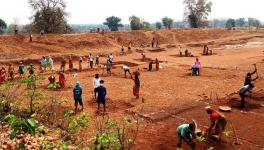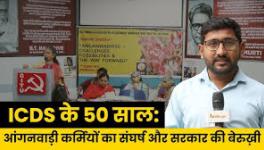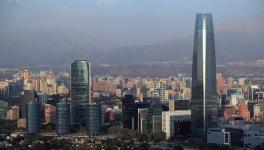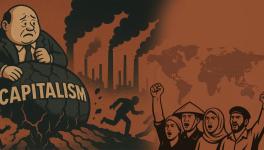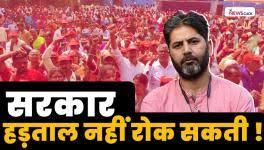Pandemic Calls for Replanning Cities to Suit Working Class Needs
The lakhs of deaths during the second wave of the pandemic due to the lack of medical oxygen, hospital beds, essential medicines and timely medical exposed the government’s mismanagement of the crisis. The problem was more severe in
cities with densely populated slums ghettoised on the basis of class, caste and religion.
The working class bore the brunt in the form of eviction, unemployment, starvation and the lack of access to healthcare and food. Construction, domestic, Anganwadi, healthcare, restaurant and shop workers, who have been contributing to the development of cities, have been left to fend for themselves.
On the other hand, the upper-middle class and the upper class were in a far better position to tackle the problem with access to Rapid Antigen Tests (RATs) and timely medical help. The celebrities, influencers and politicians kept assuring Indians that “we are all in this together” and they should remain positive and calm.
COVID-19’s second wave should have been a learning lesson for the ruling class, planners, technical experts, architects and policymakers to improve the crumbling infrastructure of cities and provide the basic rights to the working class.
The crisis laid bare the toxicity of privatisation of the economy. While posh malls, cafes and eateries are frequented by the upper-middle and upper classes, the very workers who toiled to construct them are left in the lurch with loss of livelihood during such crises. Famous Dutch sociologist Jan Breman, who has studied the working class of India, particularly in Gujarat, perceives labourers as “hunters and gatherers of work” who are left with no option but to take up whatever jobs are available even on low wages amid poor working conditions to survive.
It is high time that urban planners, architects, policymakers, municipal councillors, activists and unions start reimagining cities while prioritising the needs, aspirations and rights of the working class. This requires a structural approach and not the band-aid approach adopted by the government while looking at the nutritional, housing, transport, healthcare, education and employment needs of the people. Moreover, a huge chunk of such workers is employed contractually with no job security, adequate wages/salaries and social security benefits.
The whole approach to urban planning and crisis management is flawed. For example, under Integrated Child Development Services (ICDS)—which provides supplementary nutrition, immunisation, nutrition and education for children up to six years—for every 100 Anganwadi beneficiaries in the country, only seven are in urban areas despite 32% of the population, according to the 2011 Census, staying in cities.
The paucity of Anganwadi centres in urban areas means that the existing ones are heavily burdened. Despite Anganwadi workers and helpers performing the crucial role of reducing infant mortality and malnutrition, they are only paid an honorarium. Several Anganwadi workers unions have demanded that their efforts be recognised and compensated. They have struck work several times due to non-payment of dues and the lack of better working conditions and insurance.
Similarly auxiliary nurse midwives (ANMs), who administer crucial vaccines and provide health education, are underpaid and employed contractually despite their immense contribution to screening and tracing of the infected and providing them medicines during the pandemic.
The role of ANMs and accredited social health activists (ASHAs) is crucial in connecting slumdwellers with the public health system. According to the National Health Mission, there should be one ANM per 10,000 Indians. However, in metros, like Bengaluru, there is only one ANM per 29,000 Indians with one ANM responsible for more than 30,000 people in most cities.
The state of the healthcare infrastructure is abysmal with only 5,190 urban primary health centres (PHCs), as per a ministry of health and family welfare report published in 2019. When PHCs are not accessible or functional, local dispensaries or private hospitals, which charge exorbitant fees, are the only options left. Considering the massive population, the government should set up one general hospital in every ward or Assembly constituency.
Primary healthcare should be provided locally through community health centres, PHCs and subcentres at a decentralised level to make it accessible to the masses. The healthcare facilities have to be upgraded with more doctors, labs, pharmacists, medicines and staff to bridge the gap between public health and the working class. Shockingly, the budgetary allocation for health for 2022-23 is a mere 1% more compared to the last year.
The state of the Public Distribution System (PDS) is abysmal as well. The lack of access to ration cards mostly affected the vulnerable sections, including sex workers, the homeless and the disabled, during the lockdowns. Despite the announcements of free food grains distribution during the pandemic, even Antyodaya Anna Yojana cardholders don’t receive their share of food grains under the National Food Security Act, 2013.
Around 18.7% of women of reproductive age (15-49 years) are thin with a body mass index of less than 18.5 kg per square metre—21.2% in rural areas and 13.1% in cities, according to the fifth National Family Health Survey (2019-21). The survey also showed that 30.1% of children in urban areas are stunted. To tackle malnutrition, starvation and susceptibility to diseases among the masses, the PDS and the Mid Day Meal Scheme should be strengthened by including everyone under the universal right to food.
With more people opting for home delivery of food and groceries, polythene bags have flooded the dustbins and landfills. Sluwdwellers are forced to dump waste in waterbodies and on roads in the absence of a proper disposal mechanism. While the affluent class contributes disproportionately to the waste problem because of its ability to purchase more, the working class is blamed for dirtying cities. The use of polythene bags should be immediately banned when reusable bags are available.
Dry waste collection centres (DWCCs) managed by waste picker organisations and supervised by the municipalities should be accessible to every ward with fees proportional to the waste generated by a household and also from corporations, as per the extended producer responsibility rules. Accessible composting units, DWCCs and biogas plants can lead to the safe processing of a large quantity of waste. In addition, reusable bags should be encouraged by the PDS and local shops.
The privatisation of bus services under the PPP model, incentivisation of car sales and widening of flyovers has affected the public transport. A majority of roads are occupied by private vehicles while the masses wait to board crowded buses. Instead of disincentivising and privatising public transport and contractualisation of workers, more buses should be introduced to improve the frequency and workers employed on a permanent basis. To provide safe, efficient, accessible and affordable transport to all, transport-oriented development should be replaced with worker-oriented transport.
India needs less technocracy and more democratic and decentralised participatory governance, as envisioned by the 74th Constitutional Amendment, to plan such cities. In addition to setting up expert group committees, ward sabhas should be encouraged to keep the masses in touch with their local councillors and ward committees and directly involve them in governance.
Improving the infrastructure of primary healthcare, PDS, education, transport and waste management will not only make cities more worker-friendly but also provide jobs to a vast number of city dwellers, especially women who form the backbone of the human development in cities, like ASHAs, ANMs and Anganwadi workers. Strengthening the public infrastructure is a prerequisite for employment generation. Workers should be hired permanently at decent wages—an urban employment guarantee scheme must be explored.
Cities are not defined by the number of malls, gated building societies or colonies and bungalows but by public hospitals, schools and ration shops.
The writer is pursuing the Urban Fellows Programme at the Indian Institute for Human Settlements, Bengaluru. The views are personal.
Get the latest reports & analysis with people's perspective on Protests, movements & deep analytical videos, discussions of the current affairs in your Telegram app. Subscribe to NewsClick's Telegram channel & get Real-Time updates on stories, as they get published on our website.









